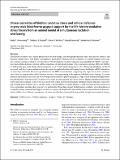Files in this item
Fitness correlates of blubber oxidative stress and cellular defences in grey seals (Halichoerus grypus) : support for the life history-oxidative stress theory from an animal model of simultaneous lactation and fasting
Item metadata
| dc.contributor.author | Armstrong, Holly C. | |
| dc.contributor.author | Russell, Debbie JF | |
| dc.contributor.author | Moss, Simon | |
| dc.contributor.author | Pomeroy, Patrick | |
| dc.contributor.author | Bennett, Kimberley A. | |
| dc.date.accessioned | 2023-03-20T11:30:07Z | |
| dc.date.available | 2023-03-20T11:30:07Z | |
| dc.date.issued | 2023-09-01 | |
| dc.identifier | 283574104 | |
| dc.identifier | e3a56203-816f-472c-9247-46dbc0b11539 | |
| dc.identifier | 85150308840 | |
| dc.identifier.citation | Armstrong , H C , Russell , D JF , Moss , S , Pomeroy , P & Bennett , K A 2023 , ' Fitness correlates of blubber oxidative stress and cellular defences in grey seals ( Halichoerus grypus ) : support for the life history-oxidative stress theory from an animal model of simultaneous lactation and fasting ' , Cell Stress and Chaperones , vol. 28 , no. 5 , pp. 551-566 . https://doi.org/10.1007/s12192-023-01332-1 | en |
| dc.identifier.issn | 1355-8145 | |
| dc.identifier.other | ORCID: /0000-0003-1603-5630/work/131588189 | |
| dc.identifier.other | ORCID: /0000-0002-1969-102X/work/131588334 | |
| dc.identifier.uri | https://hdl.handle.net/10023/27221 | |
| dc.description | Funding: HCA was supported by a studentship funded by Plymouth University School of Marine Science and Engineering. The breeding season field work was supported by Natural Environment Research Council (NERC) National Capability Funding to SMRU (NE/R015007/1). The field work in Blakeney and Donna Nook was supported by funding to DJFR from UK Department of Business, Energy and Industrial Strategy (formerly DECC) as part of their Offshore Energy Strategic Environmental Assessment programme (OESEA-14–47) and was conducted with permission from Natural England and facilitated by National Trust and Lincolnshire Wildlife Trust. | en |
| dc.description.abstract | Life-history-oxidative stress theory predicts that elevated energy costs during reproduction reduce allocation to defences and increase cellular stress, with fitness consequences, particularly when resources are limited. As capital breeders, grey seals are a natural system in which to test this theory. We investigated oxidative damage (malondialdehyde (MDA) concentration) and cellular defences (relative mRNA abundance of heat shock proteins (Hsps) and redox enzymes (REs)) in blubber of wild female grey seals during the lactation fast (n = 17) and summer foraging (n = 13). Transcript abundance of Hsc70 increased, and Nox4, a pro-oxidant enzyme, decreased throughout lactation. Foraging females had higher mRNA abundance of some Hsps and lower RE transcript abundance and MDA concentrations, suggesting they experienced lower oxidative stress than lactating mothers, which diverted resources into pup rearing at the expense of blubber tissue damage. Lactation duration and maternal mass loss rate were both positively related to pup weaning mass. Pups whose mothers had higher blubber glutathione-S-transferase (GST) expression at early lactation gained mass more slowly. Higher glutathione peroxidase (GPx) and lower catalase (CAT) were associated with longer lactation but reduced maternal transfer efficiency and lower pup weaning mass. Cellular stress, and the ability to mount effective cellular defences, could proscribe lactation strategy in grey seal mothers and thus affect pup survival probability. These data support the life-history-oxidative stress hypothesis in a capital breeding mammal and suggest lactation is a period of heightened vulnerability to environmental factors that exacerbate cellular stress. Fitness consequences of stress may thus be accentuated during periods of rapid environmental change. | |
| dc.format.extent | 16 | |
| dc.format.extent | 1250219 | |
| dc.language.iso | eng | |
| dc.relation.ispartof | Cell Stress and Chaperones | en |
| dc.subject | Cellular stress | en |
| dc.subject | Cellular chaperone | en |
| dc.subject | Adipose | en |
| dc.subject | Trade off | en |
| dc.subject | Pinniped | en |
| dc.subject | QL Zoology | en |
| dc.subject | DAS | en |
| dc.subject | MCC | en |
| dc.subject.lcc | QL | en |
| dc.title | Fitness correlates of blubber oxidative stress and cellular defences in grey seals (Halichoerus grypus) : support for the life history-oxidative stress theory from an animal model of simultaneous lactation and fasting | en |
| dc.type | Journal article | en |
| dc.contributor.sponsor | NERC | en |
| dc.contributor.sponsor | NERC | en |
| dc.contributor.institution | University of St Andrews. School of Psychology and Neuroscience | en |
| dc.contributor.institution | University of St Andrews. Centre for Energy Ethics | en |
| dc.contributor.institution | University of St Andrews. Sea Mammal Research Unit | en |
| dc.contributor.institution | University of St Andrews. Marine Alliance for Science & Technology Scotland | en |
| dc.contributor.institution | University of St Andrews. Scottish Oceans Institute | en |
| dc.contributor.institution | University of St Andrews. Centre for Research into Ecological & Environmental Modelling | en |
| dc.contributor.institution | University of St Andrews. School of Biology | en |
| dc.identifier.doi | 10.1007/s12192-023-01332-1 | |
| dc.description.status | Peer reviewed | en |
| dc.identifier.grantnumber | Agreement R8-H12-86 | en |
| dc.identifier.grantnumber | NE/R015007/1 | en |
This item appears in the following Collection(s)
Items in the St Andrews Research Repository are protected by copyright, with all rights reserved, unless otherwise indicated.

